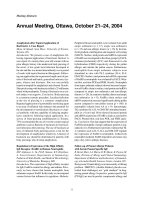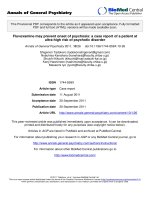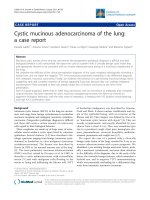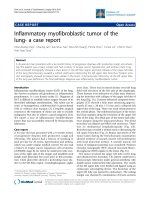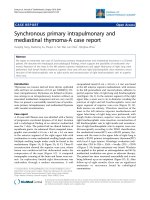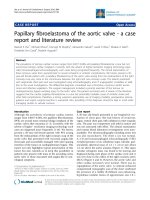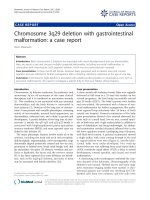Báo cáo y học: "Lamellar corneal injury by bamboo splinters: a case report" ppt
Bạn đang xem bản rút gọn của tài liệu. Xem và tải ngay bản đầy đủ của tài liệu tại đây (515.17 KB, 3 trang )
Case report
Open Access
Lamellar corneal injury by bamboo splinters: a case report
Motoko Kawashima
1
*, Tetsuya Kawakita
1
, Chika Shigeyasu
1
and Jun Shimazaki
1,2
Address:
1
Department of Ophthalmology, Tokyo Dental College, Sugano 5-11-13, Ichikawa City, Chiba, Japan and
2
Department of
Ophthalmology, Keio University School of Medicine, 35 Shinanomachi, Shinjukuku, Tokyo, Japan
Email: MK - ; TK - ; CS - ; JS -
* Corresponding author
Published: 8 May 2009 Received: 27 September 2008
Accepted: 22 January 2009
Journal of Medical Case Reports 2009, 3:7226 doi: 10.1186/1752-1947-3-7226
This article is available from: />© 2009 Kawashima et al; licensee Cases Network Ltd.
This is an Open Access article distributed under the terms of the Creative Commons Attribution License (
/>which permits unrestricted use, distribution, and reproduction in any medium, provided the original work is properly cited.
Abstract
Introduction: We report an unusual case of corneal lamellar injury caused by long bamboo
splinters.
Case presentation: A 70-year-old Japanese man visited our hospital with a bamboo injury. Slit lamp
examination revealed that a bundle of bamboo splinters had deeply penetrated the corneal stroma of
the right eye from the nasal limbus. The splinters were approximately 8 mm in length, but had not
perforated the anterior chamber. They were completely removed by superficial corneal incision
alongside each splinter with no consequences. The eye has remained healed for 3 months
postoperatively.
Conclusion: The bamboo splinters did not perforate the anterior chamber, although they were long
and hard enough to do so. This may be because the spatula-like shape and flexibility of the bamboo
splinters allowed them to penetrate the lamellar layer of the corneal stroma with ease, but with no
perforation of deeper tissue.
Introduction
Bamboo has been reported as an unusual palpebral or
orbital foreign body in ophthalmological studies [1,2].
Bamboo prefers a warm climate with high humidity, and
is common throughout East Asia. These characteristics
make it a breeding ground for a wide variety of
microorganisms such as fungi and bacteria [3,4]. There-
fore, there is a high concomitant risk of the development
of vision-threatening infections with penetrating bamboo
injury to ocular tissues. Here, we report a patient with
ocular bamboo injury where its successful treatment may
be explained by a bamboo-specific traumatic mechanism.
Case presentation
A 70-year-old Japanese man visited our hospital in January
2007 with a foreign body lodged deeply in his ocular
stroma. He had sustained this injury while felling bamboo.
At the initial examination, his best-corrected visual acuity
(BCVA) was 0.3 in the right eye and manifest refraction
was +1.25D-0.50 × 165. Bamboo splinters, approximately
Page 1 of 3
(page number not for citation purposes)
8 mm in length, had pierced the cornea from the nasal side
(Figure 1), deeply penetrating the stroma. High magnifica-
tion slit lamp examination revealed that, although they
had deeply penetrated the stromal layer, they had not
perforated the anterior chamber (Figure 1). The anterior
chamber was of normal depth, with no aqueous leakage,
and intraocular pressure was 12 mmHg.
To remove the splinters, an inclined corneal incision was
created alongside each one. This incision allowed them to
be removed completely and with ease, demonstrating an
effective way of avoiding infection from residual splinters.
The wound was sutured in place with four interrupted
10-0 nylon sutures after washing the interface. Corneal
sutures were used to facilitate wound healing, and were
removed completely after 1 week.
The eye showed no signs of infection and little scar
formation; no strong astigmatism was observed (Figure 2).
BCVA was 0.6 and manifest refraction was +2.00D - 0.75 ×
150.Hiseyehasremainedhealedfor3months
postoperatively.
Discussion
Bamboo injury is unusual, and few cases have been
reported where penetration has occurred with no perfora-
tion of blood vessels in the neck [5] or perforation of the
eye ball [1,2]. The combination of ample rigidity to allow
penetration with sufficient flexibility to allow avoidance of
perforation may offer a potential explanation for this
phenomenon.
In our patient, the bamboo splinters were long and hard
enough to penetrate the corneal stroma. It appe ars,
though, that the physical properties specific to bamboo
allow it to penetrate deeply, but with no perforation of the
anterior chamber. We believe this phenomenon may also
be partially explained by t he spatula-like shape of
bamboo, together with its flexibility, enabling it to break
the lamellar layer of collagen fibers with ease.
The foreign body was lodged deeply in his stroma from the
nasal limbus. We believe that the foreign body changed
direction after coming into contact with the nose.
Morakotkarn et al. noted that bamboo acts as a huge
reservoir of microorganisms, with 257 fungal strains being
isolated from bamboo tissues in Japan [3]. Therefore,
residual fine bamboo fragments may cause severe infec-
tion and haze [4]. This necessitates complete removal of
such bamboo fibers to prevent infection, and especially
fungal infection. In our patient, we were able to remove
the bamboo splinters localized in the corneal stroma easily
and completely by making an open inclined wound. This
may be one of the reasons why the clinical course of this
treatment was successful.
Conclusion
The bamboo splinters were long and hard enough to
penetrate the corneal stroma, but did not. This may be
explained by the spatula-like shape and flexibility of the
bamboo splinters enabling them to penetrate the lamellar
phase with ease.
Figure 1. Clinical findings at initial visit. Bamboo splinters (approximate length 8 mm, width 1.5 mm) were lodged deeply
in the stromal layer from the nasal side (A). They had not, however, penetrated the stroma, and the anterior chamber
was quiet (B). The patient showed nasal corneal scars caused by previous pterygium resection in this eye.
Vd = 0.08 (0.3× + 1.25 = cyl - 0.50A165).
Page 2 of 3
(page number not for citation purposes)
Journal of Medical Case Reports 2009, 3:7226 />Consent
Written informed consent was obtained from the patient
for publication of this case report and any accompanying
images. A copy of the written consent is available for
review by the Editor-in-Chief of this journal.
Competing interests
The authors declare that they have no competing interests.
Authors Contributions
MK: study concept and design, patient care, drafting the
manuscript, literature review, TK: editing the manuscript,
CS: patient care, data collection, literature review, JS: study
concept and design, revising the manuscript,
All authors have read and approved the final version of the
manuscript.
References
1. Uchino A, Kato A, Takase Y, Kudo S: Intraorbital wooden and
bamboo foreign bodies: CT. Neuroradiology 1997, 39:213-215.
2. Uchinuma E, Satoh A, Matsukura T, Mizuno H, Shioya N: Unusual
palpebral foreign bodies. Aesthetic Plast Surg 1997, 21:258-261.
3. Morakotkarn D, Kawasaki H, Seki T: Molecular diversity of
bamboo-associated fungi isolated from Japan. FEMS Microbiol
Lett 2007, 266:10-19.
4. Kirkness CM, Seal DV, Clayton YM, Punithalingam E: Sphaeropsis
subglobosa keratomycosis - first reported case. Cornea 1991,
10:85-89.
5. Khan MK, Sharif A, Taous A, Mostafa MG, Kundu SC, Hossain MM,
Mustafa MG: Unusual perforating foreign body in the neck.
Mymensingh Med J 2006, 15:212-214.
Figure 2. Clinical findings 2 weeks postoperatively.
Although corneal sutures were performed to facilitate
wound healing, they were removed completely after 1 week.
The patient’s eye showed no signs of infection and little scar
formation; no strong astigmatism was observed.
Vd = 0.4 (0.6× + 2.00 = cyl - 0.75A150).
Page 3 of 3
(page number not for citation purposes)
Journal of Medical Case Reports 2009, 3:7226 />Do you have a case to share?
Submit your case report today
• Rapid peer review
• Fast publication
• PubMed indexing
• Inclusion in Cases Database
Any patient, any case, can teach us
something
www.casesnetwork.com
